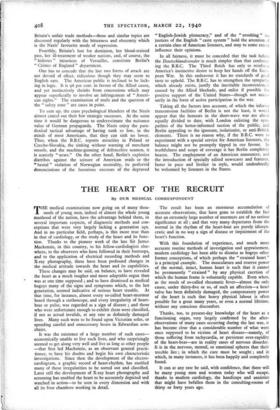THE HEART OF THE RECRUIT
By OUR MEDICAL CORRESPONDENT
THE medical examinations now going on of many thou- sands of young men, indeed of almost the whole young manhood of the nation, have the advantage behind them, in several important respects, of diagnostic methods and con- ceptions that were very largely lacking a generation ago. And in no particular field, perhaps, is this more true than in that of cardiology, or the study of the heart and its func- tion. Thanks to the pioneer work of the late Sir James Mackenzie, in this country, to his fellow-cardiologists else- where, to the observers who have followed in their footsteps, and to the application of electrical recording methods and X-ray photography, there have been profound changes in the medical attitude towards the heart and its capabilities.
These changes may be said, on balance, to have revealed the heart as a much tougher and more adaptable organ than was at one time supposed ; and to have dismissed as medical bogeys many of the signs and symptoms which, to the last generation, seemed indicative of serious heart trouble. At that time, for instance, almost every so-called heart-murmur heard through a stethoscope, and every irregularity of heart- beat or pulse, was regarded as a sign of disease ; and those who were unfortunate enough to exhibit them were classified, if not as actual invalids, at any rate as definitely damaged lives. Many such were to be found upon Victorian sofas, or spending careful and unnecessary hours in Edwardian arm- chairs.
It was the existence of a large number of such cases— economically unable to live such lives, and who surprisingly seemed to get along very well and live as long as other people —that first led Mackenzie, as an observant general practi- tioner, to have his doubts and begin his own characteristic investigations. Since then the development of the electro- cardiogram, a graphic record of heart-rhythm, has enabled many of these irregularities to be sorted out and classified. Later still the development of X-ray heart photography and screening has enabled the heart to be accurately depicted and watched in action—to be seen in every dimension and with all its four chambers working in detail. The result has been an enormous accumulation of accurate observations, that have gone to establish the fact that an extremely large number of murmurs are of no serious significance at all ; and that very many departures from the normal in the rhythm of the heart-beat are purely idiosyn- cratic and in no way a sign of disease or impairment of the heart's function.
With this foundation of experience, and much more accurate routine methods of investigation and appraisement, modern cardiology has been able to dismiss as bogeys other former conceptions, of which perhaps the " strained heart " is a principal example. The musculature and reserve power of the normal, intact, human heart is such that it cannot be permanently " strained " by any physical exertion of which the human frame is voluntarily capable. Even when, as the result of so-called rheumatic fever—almost the only cause, under thirty-five or so, of such an affection—a heart valve has been definitely damaged, the compensatory power of the heart is such that heavy physical labour is often possible for a great many years, or even a normal lifetime, without any conscious discomfort.
Thanks, too, to present-day knowledge of the heart as a functioning organ, very largely confirmed by the after- observations of many cases occurring during the last war, it has become clear that a considerable number of what were once supposed to be victims of heart disease—namely, of those suffering from tachycardia, or persistent over-rapidity of the heart-beat—are in reality cases of nervous disorder. It is in the nervous, mental; or emotional spheres that their trouble lies ; in which the cure must be sought ; and in which, in many instances, it has been happily and completely found.
It can at any rate be said, with confidence, that there will be many young men and women today who will escape, thanks to modem cardiology, the handicaps and anxieties that might have befallen them in the consulting-rooms of thirty or forty years ago.






































 Previous page
Previous page